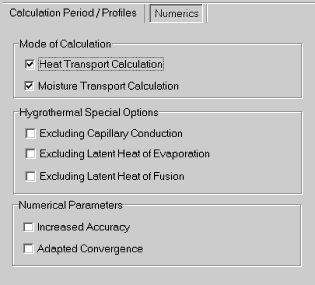1D:Dialog Numerics: Unterschied zwischen den Versionen
| Zeile 14: | Zeile 14: | ||
:<B>"Moisture Transport Calculation":</B> | :<B>"Moisture Transport Calculation":</B> | ||
:Decide whether heat and/or moisture transport shall be allowed in the calculation. | ::Decide whether heat and/or moisture transport shall be allowed in the calculation. | ||
<TABLE> | <TABLE> | ||
Version vom 10. März 2009, 12:21 Uhr
Dialog: Numerics
The options offered by this dialog allow you to control the way the calculation is done.
"Mode of Calculation":
- "Heat Transport Calculation"
- "Moisture Transport Calculation":
- Decide whether heat and/or moisture transport shall be allowed in the calculation.
|
In general, you will have activated both; an example for a case where it is useful to switch off moisture transport is the determination of the heat transmission coefficient (U-value) of a building component with a complicated measured moisture profile: To this end, write the moisture profile to a *.INI file, specify it as the initial moisture content and switch off the moisture transport calculation in the present dialog Numerics to keep the profile from dissolving.
Apply a suitable constant temperature difference across the component
by creating an appropriate KLI
file or by specifying temperature
"sine" curves with appropriate
mean values and "zero" amplitudes on either
side, start the calculation and wait until steady-state conditions have
been reached. After the calculation, obtain the heat transmission
resistance from the resulting steady heat flow. |
"Hygrothermal Special Options":
- "Excluding Capillary Conduction":
- Capillary conduction can be switched off separately; moisture transport is
- then only effected by vapour diffusion. Thus you can examine the contributions
- of both transport mechanisms to the total transport.
- If the "Moisture Transport Calculation" has been deactivated
- altogether, there is of course no capillary conduction anyway, independent
- of this option.
"Excluding Latent Heat of Evaporation",
"Excluding Latent Heat of Fusion":
If you want to examine the importance of latent heat effects, you can switch
them off and compare calculations with and without latent heat.
"Numerical Parameters":
"Increased Accuracy",
"Adapted Convergence":
If a calculation should suffer from numerical problems (recognisable by a
[1D:Dialog_InfoLastCalculationRun | great number of convergence
failures or a bad water balance]]) and a revised [##HREF##] grid can't
solve the problems, you can try to improve the calculation with the help of
these options. In general, increased accuracy is more effective than adapted
convergence. With any of these options computing time increases, of course.
Before using these options, you should check if the
numerical grid is well adapted to the problem
at hand. These points are further discussed in the help topic for the
dialog "Status of Last
Calculation" and in
"WUFI's performance and
limitations".
Version notice: the numerical options are enabled only in WUFI Pro.
